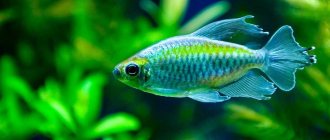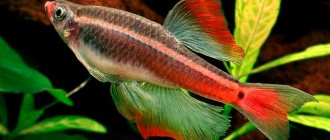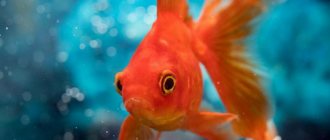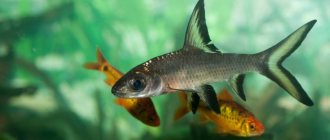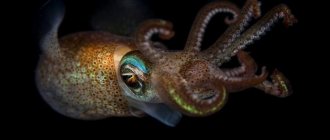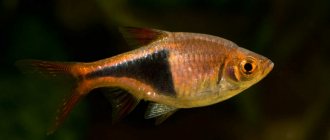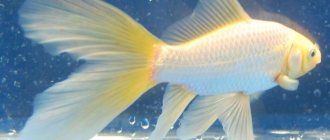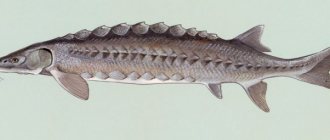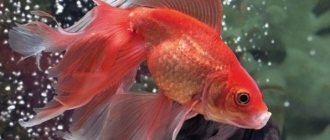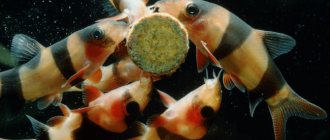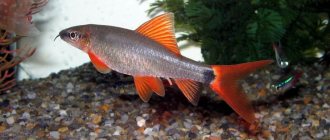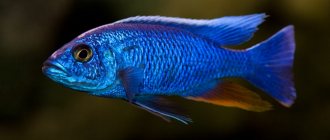5
(4)
The brilliant, bright, spectacular fish minor received the name bloody tetra for its juicy, fiery scarlet body color. Hardy and easy to keep, it is rightfully considered one of the most popular species among South American tetras. The flock minor captivates, attracts the eye, and caring for it is accessible even to novice aquarists.
Description
Minor fish are schooling in nature. When kept alone, they are aggressive or hide in shelters. Depending on the size and nature of the neighbors. A flock of 6–8 individuals has little interest in other fish.
Appearance
The body is elliptical, elongated, laterally compressed. In an aquarium, the minor fish grows up to 4–4.5 cm. The color ranges from yellow with a greenish tint to orange-red. A dark spot behind the gill covers indicates proximity to serpas.
The fins are red, with a dark gray or black edge, except for the caudal one. The color of the dorsal fin varies from gray-black to orange-red with a dark border, the characteristic shape is trapezoidal. Anal - extended to the base of the tail. The caudal fin is forked.
Behavior
Minor fish swim mainly in the lower and middle layers of the jar. Active, constantly on the move, playful. Within the flock, conflicts arise between males for primacy, but no injuries occur. They love shelters.
Lifespan
The average is 3–4 years. Under recommended conditions - up to 6 years.
Compatibility
Minors are considered good fish for community aquariums, but this is not entirely true. Only if they live with large and fast fish.
Fish that are smaller than them will become the target of persecution and terror. The same can be said about slow fish with large fins.
For example, cockerels or angelfish. They will be constantly pulled by the fins until the fish gets sick or dies.
Good neighbors for them will be: zebrafish, black neons, barbs, acanthophthalmus, ancistrus.
In a group, the character of each individual softens somewhat, as a hierarchy is built and attention is transferred to relatives. At the same time, the males pretend to fight with each other, but do not injure each other.
Content
A common mistake is to have a couple of minors. It is impossible to determine the sex of purchased young fish. Males without females quarrel and attack their neighbors. The fish show their best qualities if there are 5-6 tails in the jar. The composition of water and temperature are important when breeding. Filtration and aeration to create a sluggish flow are desirable.
Check out this addition on Instagram
Addition, extensions Flora and Fauna (@flora_i_fauna_snk) 20 Gr 2017 r. about 10:18 PST
Aquarium
For a flock of 5–8 individuals, a jar of 60 liters or more is suitable. In this case, the width of the vessel should not be less than 0.7 m. The optimal shape is a rectangular parallelepiped. Corner and cubic containers will not provide space for swimming.
Habitat in nature
The long-finned serpas minor (Hyphessobrycon eques, and earlier Hyphessobrycon minor) was first described in 1882. It lives in South America, its homeland is Paraguay, Brazil, Guiana.
A fairly common fish, found in stagnant water, with a large number of plants: tributaries, ponds, small lakes.
They stay near the surface of the water, where they feed on insects, their larvae and plant particles. They live in flocks, but often fight with each other and bite their fins.
Feeding
Live (bloodworms, tubifex worms, grindal worms, fruit flies) or frozen foods are preferred. Dry ones do not contain the necessary substances in the required volumes and swell in the stomach. Be careful with the amount of food. Fish do not feel full and may become obese. Feed once a day. Have 1-2 days a week as fasting days.
20–25% of the diet is plant foods. Feed vegetables: cucumber, blanched cabbage, zucchini. Oatmeal is good for you.
Nutrition rules
In terms of nutrition, these small fish are not capricious. You just need to follow simple recommendations for choosing food:
- The size must be appropriate. Small fish simply cannot capture food particles that are too large.
- Nutrition must be balanced. Feed is usually alternated. The condition of aquarium pets directly depends on this.
- In nature, serpas feed on small aquatic animals and insects from the surface. In captivity, you can use both live food (crustaceans, bloodworms, small insects) and dry food (special flakes, granules). Plant-based foods (dandelions, spinach, cirrus) are also suitable.
Minors feed on both animal and plant foods,
Reproduction
You will need a shaded spawning area with weak aeration. A “trough” of 12–15 liters is suitable. Water layer - up to 15 cm.
Prepare peat decoction. Add 4–6 g of peat per 100 g of broth. Use clean peat, without mineral additives: it is dangerous for fish. Cook for 25-30 minutes over low heat. After cooling, filter the precipitate. Add to the spawning tank until the water turns slightly brown. Environment Settings:
- temperature: 26–28 °C;
- hardness: up to 4 °F;
- acidity: pH 6–6.5.
To protect the eggs from being eaten, use a separator or place plants (Java moss, hornwort) on the bottom. Or plant ground cover plants.
Sex differences
Dimorphism appears after puberty. The dorsal fin of the male is elongated, the color of the female is paler. When viewed from above, the male looks lean, the female has a noticeable belly. Males are easy to distinguish by their behavior: they strive to dominate.
Origin story
It is well known that this genus was isolated in 1908 by Durbin.
Some sources give a literal translation of the word "hifessobrikon" as "small brikon" (however, it should be noted that for the Latin language its constituent syllables are rare enough to confirm this). A valid definition of the genus was made by Eigemann (1918, 1921). Today, about 110 species of fish of the genus Hyphessobrycon
, belonging to the subfamily
Tetragonopterinae
, which includes most of the charicinids kept in decorative aquariums.
The genus closest to it is Hemigrammus, Gill 1858
with which they are literally located together on the same taxonomic “fork” [1]. The difference is determined mainly by differences in the structure of the caudal fin. Also, the genus Paracheirodon is very close to it, and the debate about its isolation in scientific circles has not yet subsided, for which there are serious reasons. Over time, in the genus Hifessobricon itself, a division of species into 5 groups was identified (Hoedeman 1954, Gery 1977, G. Shterba), which is quite arbitrary and now no longer covers all species, but still allows us to at least approximately see the overall picture. In turn, these groups can be formed into two main supergroups based on characteristics characterizing body shape and color.
Main groups of the genus Hyphessobrycon
| Generalization of groups | supergroup I | supergroup II | |||
| Existing groups | Bentosi | Callistus | Bifasciatus | Heterorhabdus | Metae |
| Images of iconic species: | [2] | [3] | [4] | ||
| Body Shape: | tall, diamond-shaped; enlarged dorsal muscle | elongated, “torpedo-shaped” | |||
| Body color: | weakly expressed, or with large but barely noticeable blurry spots | with a certain toning from yellowish to intense red; with one dark spot on the anterior half of the body, except for H.georgettae | with two dark comma-shaped spots on the anterior half of the body | with two horizontal lines from head to tail: pearlescent (can be of different colors) and intense black underneath | the same, but the black line downwards, blurring, becomes a spot |
| Kinds: | N. bentosi N. rosaceus N. erythrostigma H. socolofi N. robertsi | H. eques H. georgettae H. haraldschultzi H. minor N. takesi | H.bifasciatus H.flammeus H.griemi H.equadoriensis | N. agulha H. scholzei H. stegemanni H. heterorhabdus H. vilmae H. herbertaxelrodi | N. metae H. peruvianus N. loretoensis |
Reviews
Aquarists are captivated by the exterior and cheerful behavior of the minors. They note omnivorousness and unpretentiousness to food, environmental parameters, and low cost in pet stores.
I don’t like the tattered fins of veiltails and the obligatory keeping in a flock. The difficulty of breeding confuses me.
Breeding
Reproduction of Minor does not require special skills; it is enough to create the necessary conditions in the spawning aquarium. For breeding you will need an equal number of females and males.
The tank is used in small sizes, with minimal lighting. The bottom is lined with plant leaves or moss.
Water must meet the following indicators:
| Rigidity | Acidity | Temperature |
| 6-8°dH | 6.0 pH | +27 °С |
Future parents are fed abundantly with a variety of live foods. When the males reach maximum brightness and the abdomens of the females are noticeably rounded, they can be transplanted into the spawning tank.
It is better to do this in the evening, since the process begins in the morning.
The swept and fertilized eggs fall onto the leaves of the plants. Adult fish are returned to the main aquarium, and the tank with eggs is shaded; light can destroy the clutch. The incubation period lasts two days, then the first fry appear. Initially, they feed on the yolk sac; as soon as the ability to move independently appears, the juveniles begin to be fed. In the first feeding they give ciliates and egg yolk, as they grow older they transfer to artemia nauplii and gradually to adult foods.
Photo gallery
Diseases and prevention
Minors, just like other types of aquarium fish, get sick when the immune system is weakened, the water in the tank is contaminated and when infected with other individuals.
Diseases are diverse, and some infections have different external signs. Ichthyologist specialists believe that treatment for a pet can be prescribed only when there is confidence in the diagnosis, and for this it is necessary to undergo an analysis.
In order not to waste time, but to provide timely assistance to the fish, diseases are divided according to symptoms into 3 types:
- Bacterial - combines bloating, roughness of scales, ulcers, bruising, mucus on the skin, and so on.
- Fungal - formations in the form of threads, cotton wool, and moss form on the body.
- Flagellates - rashes and holes on the skin, dots.
This is only a small part of the aquarist’s classifier; to study diseases you will need experience. However, knowing the main symptoms, they provide first aid to the pet.
As preventive measures, it is recommended to carefully monitor water quality and its chemical parameters. Keep the tank clean. Purchase food only from trusted suppliers and follow available precautions when purchasing new pets.
